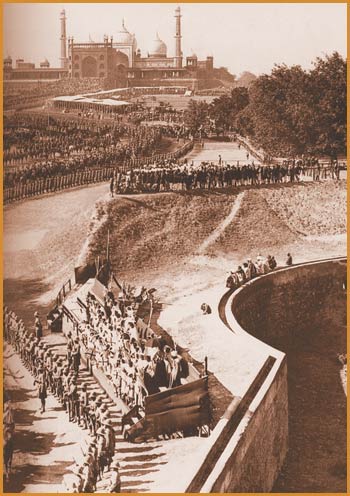
The British Empire founded a great colonial rule on Indian land in 1858. However the Indian resistance that grew strong by the middle of the 20th century forced the British rule to withdraw from these lands in 1947.
India has been governed by many different states in its history and at the end of the 19th century, the whole country came under direct British colonial rule. This colonial government brought much misery and suffering to the Indian subcontinent for over a century. The English masters treated their subjects as second class citizens and the countries rich resources were ruthlessly exploited, leaving the native population to struggle in poverty. Colonial rule ended in 1947 with the declaration of Indian independence, but the country was gripped by a new wave of violence delivered by a fanatical Indian nationalism. This movement went back a considerable time, to the 1920’s to be precise. The fascist ideologies that swept across the world helped give rise to a number of fascist underground movements in India. They would sometimes target the colonial powers and at other times the greatest minority group in India, the Muslims. They made their mark with slogans like “India belongs to Indians” and they spread quickly around the country with their educational camps, their propaganda machine and military organizations.
European fascist movements played a major role in the structural development of ultranationalist Indian organizations. Like their European counterparts, Hindu ultranationalist organizations also based their ideology on racial supremacy, espousing the error that different cultural or racial origins could not form a cohesive society within one country. They defended the view that violence could be justified in order to create national unity and if assimilation failed, extermination was the only way forward for India’s future.
The fascist regimes that swept to power in many of Europe’s countries following the end of the First World War saw the solution to social and political problems in war, conflict and violence. They maintained that violence should be used if needed in order to establish unanimity in the country, that extermination of minority groups should be resorted to if assimilation failed, and that there was only one way to liberate India.
These fascist regimes terrorized whole nations with their underground armies, their secret police organizations and militaristic philosophies, and by the end of the Second World War, shared the responsibility for over 55 million dead people between them. The first fascist regime that came to power in Europe was the Benito Mussolini government in Italy, which ruled the country between 1922-1944. After Italy, Germany and Spain came under the rule of fascist parties. The joint aim of fascist Italy and Nazi Germany was to rule, exploit and enslave all other nations and they believed the only way to achieve their goal was by war, invasion, genocide and the spilling of much blood. After the Second World War, fascism was largely consigned to oblivion and even though some neo-fascist movements sprang up in Latin American countries, England, Germany and Spain, the fascist regimes’ era seemed to be over. However, the fascist ideology and it’s policies live on around the world.
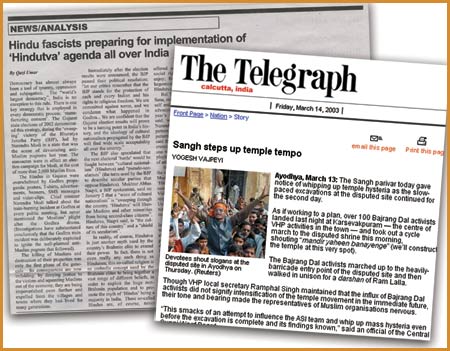
Crescent Int., 16-31 January 2003
The Telegraph, 14 March 2003
A report published in Crescent International and titled “Hindu Fascists Preparing for implementation of Hindutva Agenda all over India” described how extremist Hindu organizations had planned a series of attacks against Muslims. The Telegraph, published in India, emphasized in an article headed “Sangh steps up temple tempo” that the conflict initiated by Sangh Parivar in the Aydhya region would again enter the equation with protests all over the country
As we have seen in the previous chapters of this book, the superstitious Hindu religion envisages a cruel social order. Society consists of different classes, or castes. The upper classes control all power, wealth and bureaucracy and the so-called lower castes have a status equal to slaves in the merciless Hindu tradition. They do all the dirty work, are deprived of all their natural rights and termed to be “dirty”-untouchables by the members of the upper castes who are free to oppress, exploit and debase them. Every kind of violence, cruelty and assault is considered appropriate and indeed seen as a requirement of the Hindu religion. This ruthless system has had a profoundly negative effect in the development of Hindu ultranationalism.
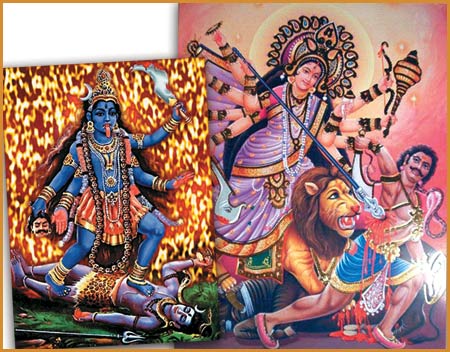
Representations of the savagery and bloodshed of Kali: Hindus perform heretical rites before images of this supposed goddess.
The superstitious Hindu religion’s erroneous teachings encourage violence and have defined radical Hindu nationalism. The vast majority of Hindu deities are described in Hindu religious texts as angry, aggressive, envious, “trigger-happy”, murderous and otherwise enjoying inflicting pain. For instance, according to these perverse beliefs, the imaginary deity Bhrigu slits, in his anger, the throat of another deity, Gautama Ahallya, and turns him into stone. Jahnumuni drinks up all the waters of the Ganges River when he is angered.69 Sita, on the other hand, is a so-called deity who is verbally aggressive, angry, haughty and merciless and Devi is ferocious, aggressive and always fighting.70 Hindu scriptures thus literally make violence sacred and present it as a fact of life, which is why violence is so great a part of life and so natural for some Hindus who espouse these superstitious views.
When analyzing extremist nationalism in India, it is necessary to consider the influence of Hinduism on this ideology as a great many Hindus see their superstitious religion as a comprehensive culture that encompasses every aspect of life. Radical Hindu nationalism’s fundamental aim is to revive superstitious Hindu traditions and if necessary, to impose these Hindu traditions on India whether the nation wants them or not. Hindus defend the view that, in the face of centuries of long occupation Hinduism became less and less a part of everyday life, and in order to reverse this trend and strengthen Hindu unity, these superstitious beliefs need to be reintroduced into people’s lives, by force if need be. By Hinduism they mean the worship of idols, the caste system, the bigotry that views women as second class citizens, and the inhuman practices that seek to assimilate non-Hindus. Radical Hindu nationalists seek to realize these changes at all costs and they are resolved to achieve this by any means. One such method is to incite people’s feelings of violence, aggression and hate.
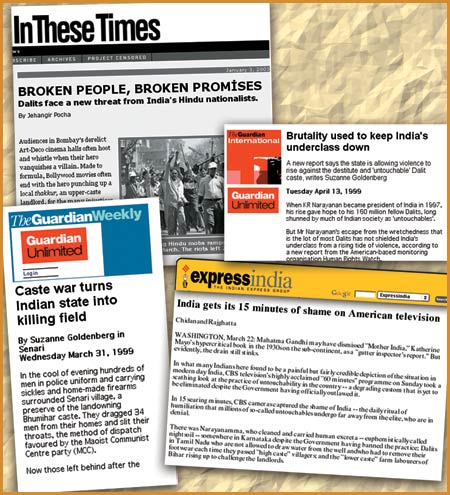
In These Times, 3 January 2003
In These Times carried a report headed “Broken people broken promises” referring to attacks on daliths by Hindu nationalists.
The Guardian, 13 April 1999
The Guardian, 31 March 1999
Expressindia, 31 March 2003
Hindu nationalists’ aim to reinvigorate superstitious Hindu traditions that have persisted for hundreds of years. The caste system occupies pride of place among these traditions. That is why they resort to all possible means to hinder movements opposed to the caste system, which have grown enormously in India in recent years. The above reports are evidence that the oppression caused by the caste system is still going on. A video film aired on the American channel CBS that documented the cruelty meted out to daliths was described by Expressindia as “India gets its 15 minutes of shame on American television.” Two separate reports in the British daily The Guardian, one dated 31 March, 1999, and headed “Caste war turn Indian state into killing field,” and the other dated 13 April, 1996, with the title “Brutality used to keep India’s underclass down” discussed the conflict between the different castes.
The umbrella organization that represents radical Hindu nationalism is the Sangh Parivar, which is an umbrella political organization that unites under its name all the extreme nationalistic parties and organizations, official or clandestine. The BJP (Bharatiya Janata Party- India’s People’s Party), which was in power at one time, the VHP (Vishwa Hindu Parishad - World Hindu Council), Shiv Sena (Fascist Front) and many other large or small extreme nationalist groups are counted among Sangh Parivar’s member organizations. However the most important of these, from the radical Hindu nationalist’s perspective, is the RSS (Rashtriya Swayemsavak Sangh- National Volunteer’s Army)
The RSS was formed in 1925 and is acknowledged to be the organization responsible for the present day attacks on Muslims and other minorities. It is the cornerstone of Hindu nationalist extremism. Today there exist a number of different nationalist political parties and organizations, but all of their most active militants have gone through the RSS’s training program. India’s government, opposition parties, military personnel, and security forces draw a majority of their personnel from a pool of RSS militants. At the top of the list of these militants come Atal Bihari Vajpayee, who recently served as prime minister, and his Cabinet.
The RSS was founded by Keshav Baliram Hedgewar in 1925 and bears a striking resemblance with the earlier fascist organizations of Italy and Germany. This resemblance was not the only connection to Europe’s fascists. One of the RSS founders, BS Moonje, went to Italy and was briefed by the Mussolini government. The Italian investigative writer Marzia Casolari, known for his research on Hinduism, documented the close relationship between the elite of the RSS and the Mussolini regime in great detail in his work titled “Hindutva’s Foreign Tie-up in the 1930s – Archival Evidence”. According to Casolari, representatives of the Mussolini regime and extreme Hindu nationalists had many meetings. The formation of the RSS, the formulation of its ideology, the establishing of its framework, and the strengthening of its youth training camps were all inspired by Mussolini’s Italy.71
The RSS turned to military training soon after its formation, much like its Italian and German counterparts. . Mussolini’s quasi-military “Black-Shirts” and Hitler’s SA (Sturmabteilung -Storm Units) provided the blueprint and the new organization was named “Shakha”. Skakha’s sprung up across India. Six and seven year old children were trained to become fascist militants against the “enemy” (i.e., Muslims and Christians) and would ultimately serve as the nucleus for a fascist army. Mussolini’s social Darwinist statements, and the Fascists twisted outlook, such as “established peace is damaging and only warfare can bring out the best of human power”, were held in high esteem among the members of the RSS.
The aggressive Hindu nationalism took form in the 1920’s and spread across India in the 1930’s with the militants trained in the Shakhas. This organization is still very much active to the present day. It is estimated that there are 300,000 shakhas across India and 50 -100 youth are being trained at any given time in each shakha, or in other words, they are receiving a radical and aggressive nationalist indoctrination.72 These figures suggest that there are currently at least 30 million fanatical Hindu militants ready to carry out the most merciless activities. Considering the number of militants who went through the Shakha training over the years it becomes evident that this number is likely much higher at the present time.
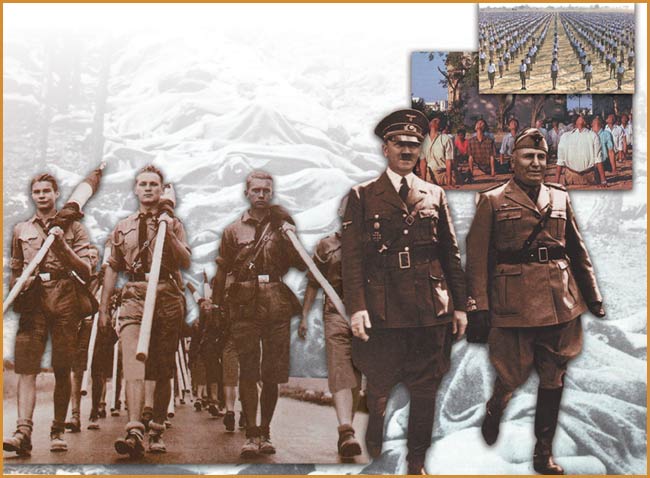
(Side) Sangh Parivar takes fascist leaders such as Hitler and Mussolini as role models during the education of young Hindus.
The leaders of the RSS were also quite supportive of Hitler’s racial policies in addition to those of Mussolini’s. One of the leaders of the RSS, Hedgewar, stated that national unity could only be achieved in the absence of non-Hindus like Muslims and Christians, because according to him, non-Hindus could neither understand, practice, nor appreciate Hindu traditions, culture or ideology. Hedgewar’s distorted perspectives became even more radical under the leadership of the RSS’s second president, Madhavrao Sadashivrao Golwalkar. “We or Our Nationhood Defined”, published by Golwalkar in 1938 contained many favorable references to Hitler and his irrational and illogical theories of racial supremacy. The following are some excerpts from Golwarkar’s book:
It would be worthwhile to cite a few excerpts here: «German race pride has now become the topic of the day. To keep up the purity of the race and its culture, Germany shocked the world by her purging the country of the Semitic races—the Jews. Race pride at its highest has been manifested here. Germany has also shown how well-nigh impossible it is for races and cultures, having differences going to the root, to be assimilated into one united whole—a good lesson for us in Hindusthan (i.e., the land of Hindus) to learn and profit by.73
A 2002 report prepared by the Concerned Citizens Tribunal, a civil society initiative consisting of India’s most eminent lawyers and academics, provided detailed information about the education given in organizations affiliated to Sangh Parivar. The report described how feelings of hatred were inculcated in young people undergoing training under the VHP and Bajrang Dal, the leading members of the Hindutva movement, how they can kill anyone opposing them at a single nod from their leaders, rape and pillage houses, engage in looting and violate all the laws.
The report concentrated on young people receiving training at the “shakhas” being given great guarantees. They are taught that, by means of the BJP government, they will always be protected and need therefore have no fear of the law or the security forces. The report also contained admissions from Shakha members who had undergone training by radical Hindu groups. One such, who had received training at a “Shakha” affiliated to Bajrang Dal provided a detailed description of secret meetings, how methods of attacks were to be employed against Muslims, how the organization would protect any Shakha member martyring a Muslim, how his family would be looked after if anything happened to him, and how all a member needed to do in the event of being arrested was to show his party membership card and the police would immediately release him. Shakha members are also taught the importance of loyalty to the organization, how loyalty to Hindutva ideology is more important than anything else, that one must be ready to commit all kinds of attacks at whatever time of night one may be woken up, and that one must never raise any objections.
The report stated that the most important part of the training given at the Shakhas is the gathering of information about Muslims living in the region. Young people are taught to use weapons of all kinds, especially the knife and sword, regarded as sacred by Hindus. The report went on to say that young people are subjected to wide-ranging anti-Muslim brainwashing, and that the ultimate aim of the organization is to “build an army with a strong desire to destroy Muslims, well armed, physically powerful, filled with hatred and trained to carry out attacks of all kinds..
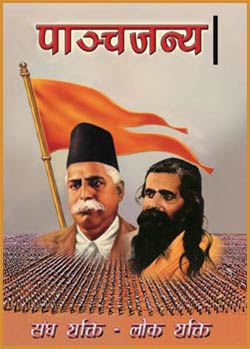
A poster belonging to the fascist RSS party. RSS leaders Hedgewar (left) and Golwarkar (right)
Golwarkar’s advice to radical Hindu nationalists is as follows:
This is the lesson the «Guruji» wants Sangh volunteers to learn: «From this standpoint sanctioned by the experience of shrewd old nations, the non-Hindu peoples in Hindusthan must either adopt the Hindu culture and language, must learn to respect and hold in reverence the Hindu religion, must entertain no idea but the glorification of the Hindu race and culture, i.e., they must not only give up their attitude of intolerance and ungratefulness towards this land and its age-old traditions, but must also cultivate the positive attitude of love and devotion instead; in one word, they must cease to be foreigners or may stay in the country wholly subordinated to the Hindu nation claiming nothing, deserving no privileges, far less any preferential treatment, not even citizen’s rights.74
It must be stated here that the goal of “making society uniform at any costs”, desired by the Nazis as well as Hindu fascists, is contrary to Islam moral values. The Hindu fascists sought to force the people to choose between adopting a Hindu identity and ideology or to live as slaves. The Nazis applied the same despotism, albeit in an even more horrific fashion on non- German minorities. According to Islam different races and religious denominations can coexist peacefully within one nation. They all are treated fairly and with affection. Allah reveals in the Qur’an that people have been created as different races so they can get “to know each other”. (Surat al-Hujurat: 13) Therefore, in a society ruled by the morality of Islam, no one will be discriminated because of his ethnicity. Affection and understanding towards members of different religions is ordained in the Qur’an: “There is no compulsion where religion is concerned.” (Surat al-Baqara: 256). Many verses of the Qur’an command that the rights of adherents to other religions must be respected, and that they must be allowed to live in the best manner possible, and protected and safeguarded, especially Christians and Jews. This is why in the history of Islam, in societies dominated by the morality of the Qur’an, non-Muslim minorities lived in an atmosphere of true peace and security and practiced their faith and traditions free of fear. They were not oppressed, they were not forced to act against themselves, and no one tried to enslave or exterminate them because they were different.

Hindu nationalists who carry out daily attacks on Muslims and neo-Nazis who follow in Hitler’s footsteps are today’s representatives of fascist ideology.
Even if at present, certain circles try to portray Islam differently, anybody who takes the opportunity to study the Qur’an and the life of our Prophet (may Allah bless him and grant him peace), and has a good grasp of history is aware of the understanding Islam ordains. One of these is the well-known author Amin Maalouf. The renowned French author of Christian–Lebanese origins writes in his book Les Identitées Meurtrières (Deadly Identities) that the history of Islam is full of examples of affection and justice:
“From the very beginning of Islamic history its society was easily suitable for co-existence. At the end of the last century (the 19th century) more than half the population of Istanbul, the capital of the greatest Islamic nation, consisted of non-Muslim minorities like Greeks, Armenians and Jews. Can you fathom a Paris, London, Vienna or Berlin in the same era where more than half the people are non-Christians, for instance Muslims and Jews? Even today, many Europeans would feel annoyed hearing the muezzins call to prayer. I am not passing judgment, I am just stating a fact; throughout the history of Islam, coexistence and tolerance were real for a long time. For me, the history of Islam proves the infinite potential of coexistence, tolerance and effective dialogue in Islam.”75
As it has no interest whatsoever in establishing “coexistence and effective dialogue”, it is not surprising to see that radical Hindu nationalism seeks to either have minorities surrender their identities or be enslaved, and found inspiration in Nazism, because they essentially share the same pagan views and anti-Semitic hate.
There are fundamental ties between Hinduism and Nazism. It is well known that establishing the supremacy of the Aryan race making its culture dominant across the world is the central theme of the Nazi ideology. These “Aryans” are the same race that founded the superstitious Hindu religion.
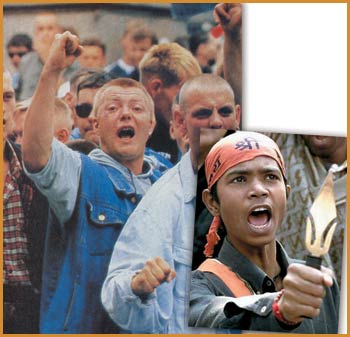
Like the neo-Nazis, fanatical nationalists in India receive considerable support from the parties in power.
In the previous chapters we had established that Hinduism was founded by the Aryans who invaded Northern India from the Northwest and occupied the country between 2500-1500 BC. It was the Aryans who created the merciless caste system, put themselves on top of the caste system, and made idolatry central to this superstitious religion. In short, Hinduism is an Aryan creation. Historians speak of the “Indo-Aryan” language and culture. Another important culture that developed around the same time was the “Semitic” culture of the Middle East with the difference being that this culture’s religion was based upon Divine revelation, and believed in the one Allah as opposed to Indo-Aryan idolatry. The most prominent of these Semitic people are the Arabs and Jews.
The majority of European people are of Indo-Aryan origin which is why before Christ, European history is full of idolatry, warfare, barbarism and cruelty as envisaged by the Indo-Aryan culture. But from the 1st century AD onwards people began to free themselves from the erroneous features of this perverted culture by entering the Christian faith, believing in the One Allah and adopting the morality of the Divine religion. In other words, the eventual domination of Europe by Christianity equaled the defeat of the pagan Indo-Aryan culture.
However, a strange ideology was born in 19th century Europe. One that was hostile to the Semitic culture (and also to Divine religions), sought to revert to the superstitious Indo-Aryan culture, one that was racist and neo-pagan. The Encyclopaedia Britannica explains the origins and this perverse ideology’s connection to Nazism as follows:
“In the 19th century a new ideology was born, defended fervently by Comte de Gobineau and than later by his follower Houston Stewart Chamberlain. This ideology asserted that the Aryan race, speaking Indo-European languages, had been the architects of all progress achieved by mankind and that it was a race morally superior to Semites, the yellow race and the blacks. The Nordic, or in other words, Germanic peoples were considered the purest Aryans. Before this idea was disproved by anthropologists in the second half of the 20th century, it was adopted by Adolf Hitler and the Nazis and would form the basis for the German regime’s policy of exterminating Jews, Gypsies and other non-Aryans”.76
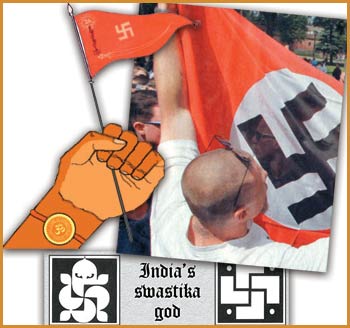
The "Swastika" is another point that Nazis and Hindu nationalists have in common. (below) The swastika is a symbol of the fictitious Hindu deity Ganesha.
Reviving the pagan and racist Aryan culture, which is also the basis of Hinduism, was central to the Nazi ideology. The founders of Nazism had taken a great interest in Hinduism. The creator of the Nazis’ occult ideas, Helena Petrovna Blavatsky, had traveled to India in her quest to discover the roots of paganism, and lived there for many years as an admirer of Hinduism. Another leading figure of Nazism, Guido von List had founded the List foundation in 1904 at Vienna. One of the most notable aspects of this foundation was that Hinduisms Tantra rituals were practiced there. The infamous lightning-bolt symbol made of two S’s, side by side, was his brainchild, and it was adopted later by the SS, the Schutzstaffel, Adolf Hitlers’ Praetorian Guard.77
The infamous swastika, the symbol of Nazism, was originally a Hindu symbol. The word “Swastika” in Sanskrit means “of pure descent” and was used to denote the Aryans, founders of the Hindu religion. The swastika was first used in Germany by an occultist organization known as the Thule Foundation, from where the Nazis appropriated it. Hitler explained in the 2nd volume, 7th chapter, of his infamous book Mein Kampf (My Struggle), that the Swastika was an Aryan symbol.
The swastika is still widely used in India at the present as it symbolizes the imaginary deity Ganesha of the Hindu faith. An article titled “India’s Swastika God” had the following to say on the subject (Surely Allah is beyond all the expressions at the beginning of and throughout the text):
“For millions of Hindus, Ganesha is the most important imaginary deity in the Hindu firmament because they can only through him make their prayers reach all the other deities in the spiritual universe…The swastika, Ganesha’s main symbol, is seen to denote the crossroads between the two worlds: the physical world of everyday life and the concealed and timeless world of spirituality, magic and legends. Wherever you go in India, you can see the swastika; it is used by housewives to protect their doorways and entrances, by priests to decorate their sermons and offerings, and by businessmen to bless the opening page of their account books.”78
The Nazis interest in Hindu symbols and other superstitious Far Eastern religions is a fact established in great detail by historians. Renowned historian Nicholas Godrick-Clarke of Oxford University wrote one of the most important books on this subject: “The Occult Roots of Nazism” (1992)- Clarke explains that the Nazis interest in Hinduism and other pagan beliefs wasn’t just on a symbolic level, but that they had much work done in support of these pagan religions.
There have been some interesting characters among the Nazis who came under the spell of neo-Aryan and neo-pagan ideologies, and ended up devoting their lives to Hinduism. Another book written by Nicholas Goodrick Clarke, “Hitler’s Priestess: Savitri Devi, The Hindu-Arian Myth and neo-Nazism”, explains that the fanatic Nazi Savitri Devi worked tirelessly in India to support Hitler.
Savitri was born in London in 1905 to Greek and English parents and her given name was Maximiani Portas. She began to develop an inexplicable admiration for the idolatrous Aryan culture as she grew older, and left for India in 1932 to investigate the roots of Aryan civilization. She took the name Savitri Devi as an ignorant admirer of Hinduism. An article written on her irrational and illogical ideology and activities states:
“India fascinated her — she noted now even a street-side vendor would discuss the Mahabharat in the morning. She had great admiration for the Brahmins, who she saw as a pure race. Her championing of Aryan-Nazi causes and Hinduism led to her entering the political scenario in India in between the wars. By the late 1930s, she was involved with Hindu nationalist movements like the Hindu Mahasabha and the Rashtriya Swayamsevak Sangh - then growing rapidly to counter Muslim ascendancy.
In early 1937, Savitri Devi met Srimat Swami Satyanand, president of the Hindu Mission in Calcutta, and offered her service to the mission. She told Swami Satyanand that India was the only country that honoured Aryan gods and could stop the influence of the Jews. Satyanand, clearly impressed, told her that Hitler, of who Savitri was a devout follower, was a supposed avatar of Vishnu — a force that would preserve the cosmic order.”79
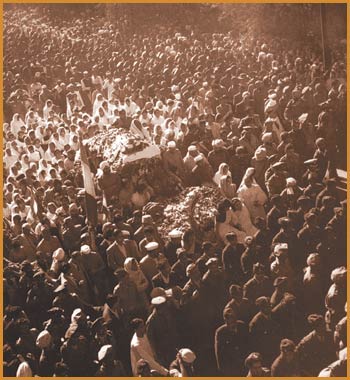
The funeral in Delhi on 31 January, 1948, of Mohandas Gandi, who was killed by Hindu extremists.
In other words, with a most perverse and distorted logic, the radical Hindu nationalist movement considered Hitler to be the “embodiment of the Hindu god Vishnu”! This erroneous belief demonstrated the partnership of Nazism and Hinduism, both being utterly irrational beliefs. A prominent aspect of this sinister partnership was anti-Semitism, or in other words hostility towards the monotheistic Semites. Nazi anti-Semitism targeted Jews and, to a lessor extent, Christians. Hindu anti-Semitism targeted the Muslim population on the Indian subcontinent. The writer continues:
“In 1939, she published A Warning to Hindus under the auspices of the Hindu Mission. In the book, she scorned the Congress for its secular policies and said there was no India but a Hindu one and warned the Hindus not to let the Muslims overwhelm them.”
Such dangerous “calls” continued to be made throughout the 1930’s, leading to an ever growing radical Hindu bigotry that was to culminate in the 1940’s with bitter consequences. With the independence of India, followed by the formation of Pakistan as a separate state, the tensions between Hindus and Muslims escalated with radical Hindu attacks on Muslims causing the death of ten thousands of innocent people. Hindu fanaticism went as far as targeting even moderate Hindus, and culminated in the assassination by a fanatic Hindu of Mahatma Gandhi who defended the view of Muslims and Hindus coexisting peacefully side by side.
Looking at radical Hindu nationalism in the era before the Second World War, it is possible to see anti-Semitism targeting Muslims and much admiration for the Nazis. Savarkar, one of the leaders of the RSS, compared the situation of Jews in Germany to the Situation of Muslims in India, in his own eyes, in a speech on the 14th of October, 1938. He was suggesting that it was appropriate to have Jews expelled from Germany, if necessary by force. He also suggested that Muslims and Hindus could not form one nation and that “minorities had always to submit to the majority view”.80 Indian author Arundhati Roy describes the fascist nationalism of “Sangh Parivar” (united family) as follows:
“While the parallels between contemporary India and prewar Germany are chilling, they’re not surprising. (The founders of the Rashtriya Swayamsevak Sangh [RSS], the National Volunteer Force that is the moral and cultural guild of the BJP, have in their writings, been frank in their admiration for Hitler and his methods.) One difference is that here in India we don’t have a Hitler. We have instead the hydra-headed, many-armed Sangh Parivar — the «joint family» of Hindu political and cultural organizations, with the BJP, the RSS, the VHP and the Bajrang Dal each playing a different instrument. Its utter genius lies in its apparent ability to be all things to all people at all times.
The Sangh Parivar speaks in as many tongues. It can say several contradictory things simultaneously. While one of its heads (the VHP) exhorts millions of its cadres to prepare for the Final Solution, its titular head (the Prime Minister) assures the nation that all citizens, regardless of their religion, will be treated equally. It can ban books and films, and burn paintings for «insulting Indian culture.”81
Dr. Partha Banerjee, an expert on the Sangh Parivar, describes in his work “The Sangh, What is it and what is it not?” the similarities between the Hindu movements and their fascist European counterparts and states that they stand for “a revival of old traditions of racial supremacy, a hierarchic and military structure, unconditional loyalty to the leader and aggressive foreign policies...” He reaches the following conclusion:
“Every single day, RSS, in its militaristic shakhas or gatherings, preaches to its workers and sympathizers that the “eldest nation of Bharatvarsha” was the “greatest” on earth and that its inhabitants were “happy, prosperous, and religious”. The Sangh leaders never forget to mention that all the ills of India began when, due to the disunity of the Hindu race”, Muslim and then British aggressors invaded and took over this “holy land”. The long term goal of the Sangh Parivar is, of course, to bring back that “past era of glory” by creating an “Akhand Bharat” (i.e., an Undivided India ranging from “ Himalaya to Kanyakumari” and “Gandhar to Brahmadesh” (i.e., from Tibet in the north to the southern tip of India, and from Afghanistan in the west to South East Asia including Burma, Laos, Thailand, and Cambodia) –culturally and politically. This dream of “unity” is to be reached by organizing Hindus from all around the globe.
The RSS is indeed a hierarchical, militaristic organization that actively practices regimentation… An aggressively nationalistic foreign policy has always been at the forefront of RSS propaganda.”82
The Sangh Parivar is a great threat to all minorities living in India, as well as the Indian nation as a whole, because it does not restrict itself to carrying on the group struggle with “hot” slogans, but has also carries out bloody assassinations, killings and arson attacks. It is estimated that the Sangh Parivar is responsible for more than 20,000 deaths in the country since the assassination of Mahatma Gandhi.83 The escalation of violent attacks carried out by the radical nationalist movement has drawn the criticism of Indian intellectuals too. M. Mohanty, of the Delhi University says: “Increasing intolerance among the Hindu fundamentalist organizations, which pose a grave threat to democracy, are an indication of the rise of fascist forces in India”, “What happened with European fascism is now happening with Hindus,” he told CNSNews.com.84
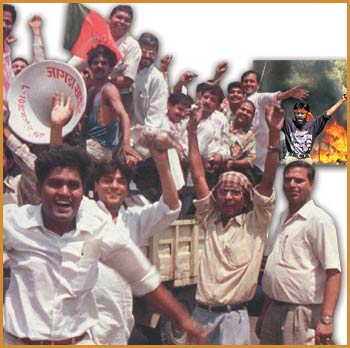
Fanatical Hindu nationalist demonstrations are organized by parties that belong to Sangh Parivar. These demonstrations thus attract full support from both the government and the opposition.
There are a great number of political parties, movements and organizations with racist tendencies. The activities of the neo-Nazis in Germany, the skinheads of England, the Ku Klux Klan in the USA and many other fascist organizations around the world are well known, but the situation in India is altogether different, because in India, a racist organization or, in one word, the Sangh Parivar, is capable of attaining power. This rule is not limited to the government but controls the entire country including the opposition, the military and the bureaucracy. Dr. Partha Banerjee spent fifteen years in a Shakha, the grass roots organization of radical Hindu nationalism, and related his experiences as an “ex-militant” in his interesting book In the Belly of the Beast: The Hindu Supremacist RSS and BJP of India—An Insider’s Story. In the first few years he spent in the Shakha, he experienced it as a place where one played with his friends and sang songs. His subsequent feelings now are as follows:
“But I must confess—I am scared today. When I think about the «Sangh» now, a nightmarish metaphor comes to my mind. I keep perceiving the «Sangh» as a continuously expanding creature like some mutated ominous insect inside an ancient cocoon—an insect that has mutated only to expand and eat everything it grabs but never to come out of its shell. It does it so slowly but surely that although it is potentially a great danger, nobody understands how perilous it is—one reason is that nobody can see it. Some find it a playful big cocoon lying in a remote corner of the colorful woods chewing away to its heart’s content, some find it an unsightly object to crack jokes about, some find it only a subject of interest to discuss among academic circles. But the insect keeps growing and mutating and devouring anything it gets. It nourishes itself from all the youthfulness and freshness of its surrounding nature and becomes bigger, stronger, and uglier.”85
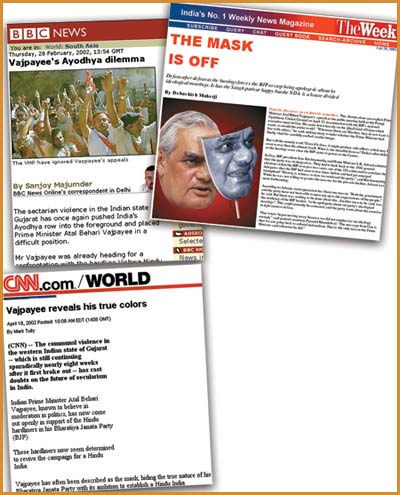
The Week, 28 Nisan 2002
BBC, 28 Şubat 2002
(top right) The Week, one of India’s most respected magazines, described how Vajpayee, who had presented a moderate image for many years, had finally revealed his true face with his aggressive policies, in an article titled “The mask is off”
CNN, 18 April 2002
The strongly worded speech given by Indian Prime Minister Vajpayee attracted wide coverage from the world press. Vajpayee, a supporter of Hindu nationalists who justifies attacks on Muslims, said: “Only Hindus can decide how free members of other faiths living in India can be.” The speech was covered by CNN under the headline “Vajpayee reveals his true colors” The report, written by Mark Tully, stated that Vajpayee also supported Mayor Narendra Modi, regarded as responsible for the Gujarat attacks. In a report titled “Vajpayee’s Ayodhya dilemma” the BBC stated that extremist Hindu nationalists were very powerful in Vajpayee’s party, and that the opinion that Vajpayee had finally revealed his true face was becoming more prevalent across the world.
The BJP is one of the three big members of the Sangh Parivar and the party chairman, Atal Bihari Vajpayee is an old RSS militant and a fanatic Hindu nationalist. 85% of the BJP members come from the RSS and these people are defined by pundits and intellectuals in the Indian media as RSS militants disguised as politicians. The popularity of the BJP is thought to be based on the fanatical language it uses against both the Muslim and Christian minorities. Vajpayee has sided with and supported the Hindu militants whenever they carried out attacks on Muslims and other minorities. Some circles try to portray him as a moderate politician, but he revealed his deep connections with the RSS, with which he first made contact in 1939, in an article he wrote for the RSS’s official press, the New Delhi, under the title “The Sangh is my Soul”. He wrote that he loved the RSS’s ideology, that he appreciated the RSS’s attitude toards the people, that the Sangh was like his family and “we are all united”.86
When Vajpayee first came to power he was considered to be a moderate politician by the world. He promised to end the conflict between Muslims and Hindus, and to deliver peace to the country, but this moderation was short-lived. In the first period of the BJP government Vajpayee revealed his true colors in the face of frequent attacks on Muslims by Hindu militants. He did nothing to apprehend those who were responsible for these attacks, but chose to back the security forces and administrators, who had cooperated with the militants in these attacks, and he continued this stance throughout his time in power. In an article published on the CNN website entitled (Vajpayee Reveals His True Colors) it was said that to begin with, Vajpayee showed a moderate side to his personality, but in time revealed his true colors by expressing his support for radical Hindus. The article also stated that the BJP was formed by the most fanatical believers in Hindu nationalism, and that Vajpayee hid his fanaticism initially behind a mask, which had eventually fallen off. Vajpayee openly attacked Muslims in a speech to his party’s ruling council and stated that Hindus would decide the degree of freedoms granted to other religions. Another important subject which CNN’s article touched upon was the fact that the BJP decided to hold an election in the immediate aftermath of the killings, rape, arson and looting carried out against Muslims in Gucarat (Gujarat), in order to take advantage of the support of some of the local population this situation brought them.87 During the election campaign, Vajpayee staunchly defended the organizers of this genocide, the RSS, which was responsible for the death of thousands of Muslims and termed it as a “cultural and social organization”.88
A famous journalist in India, Praful Bidwai, revealed the relationship between the BJP and the RSS as follows in an article titled “Hindu Supremacists Reign Supreme” that appeared in the Asia Times newspaper on November 17, 2000:
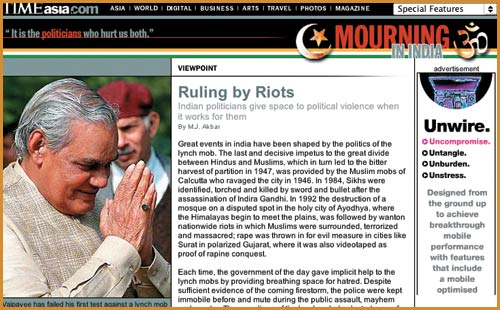
(above) A report titled “Ruling by Riots” in the Asian edition of Time magazine examined how Vajpayee, who thought that remaining silent in the face of the slaughter of Muslims in Gujarat would increase his vote, supports the Hindutya movement.
“Historically, the BJP and its predecessor, the Jana Sangh (founded in 1951), have recruited supporters through the Rashtriya Swayamsevak Sangh (RSS, National Volunteers Corps), a secret society-type militarist all-male organization which claims 600,000 members. The RSS acts as the BJP’s mentor, ideological master and organizational gate-keeper. It has parented forty-odd other fronts, most importantly the Vishwa Hindu Parishad (VHP, World Hindu Council) and Bajrang Dal, which is active in street-level mobilization.”89
One of the political member organizations of the Sangh Parivar is the extremely militant Shiv Sena. Its members openly voice their racially motivated aggression and actively encourage the radical Hindu militant’s attacks. The racist leader of Shiv Sena, Bal Thackeray, is notorious in his praise of Hitler and Nazi Germany in his interviews. Thackeray believes that democracy is not a suitable system of governance for India and states that it needs to be governed by a “positive dictatorship”.
At the present time, there is a huge propaganda campaign in progress aiming to strengthen the Hindutva (Pure Hindu Nation) movement by winning further ideological support for its activities from the people. It is supported by all the radical nationalist groups mentioned above. Over 200 different organizations are campaigning actively in India, and various radical nationalistic Hindu groups are active in America and Europe. Thousands of books and other documents are printed and websites designed solely for the purpose of spreading the Hindutva ideology. All these documents are based on distorted information which clouds the people’s perception of facts, making them thus vulnerable to provocation against minorities. These booklets disseminate lies to the effect that Hindus have been maltreated by centuries of tyranny by both Muslims and Christians, and they are blamed for all the ills of the country.90 This smear campaign smacks of the propaganda directed against Jews by the Nazis in the 1930’s. The extent of the RSS’s control over India is revealed in great detail in an article titled “The New Indian Right- Soldiers of Hindutva” and published by Achin Vanaik, a lecturer at the New Delhi Third World Research Academy known for his work on the Hindutva movement:
“Today, the RSS far outstrips the Left in numbers (estimated at over 2 million), organised strength in civil society (40,000 shakas or branches), and morale. It runs thousands of schools and has a plethora of front organisations for all sections of society, from housewives to pensioners to retired military personnel, unmatched by any other force. Its nervous system is a saffron brotherhood of pracharaks, several thousand supposedly celibate, spartan, full-time organizers, incorruptibly devoted to the pure Hindu Rashtra of their dreams. The all-male local shakhas are animated by a powerful ethic of loyalty and obedience, with an emphasis on physical culture and body-building through calisthenics and drill. Neighbourhood implantation is strong: as guardians of wisdom, the shakha will only allow a boy to attend with the consent and daily knowledge of his family. The campaign against the Ayodhya mosque, the greatest in scale and depth since the National Movement in India, would have been impossible without the unparalleled local infrastructure and unified central command of the RSS. The Hindutva phenomenon is more deep-rooted and more difficult to destroy. Fascism in power had one key instrumentality: the State. Hindutva has two: the State, and the RSS as the “skeleton” (and soul) around which the anatomy of the “new India” is to be built. The ultimate defeat or retreat of fascism from state power signalled its dissolution. This is not so for the Sangh.”91
As Vanaik said, Sangh Parivar wants to establish the Hindutva ideology on Indian soil or to put it differently, it is resolved to bring about the rule of a dark Hindu fanaticism. To achieve this, they want to exterminate all non-Hindu minorities in India just like their ideological relatives, the Nazis, made their country “Judenrein” (cleared of Jews). That is why they have increased their oppression, terror, violence and other efforts to subdue their primary target community, the Muslims, since the 1990’s. Following their ascension to power, they have continued their activities with the financial and political backing of the state. The past ten to fifteen years was marked by great sufferings, losses and deaths for the Muslim community in India. Not even the events that drew the attention of the global community suffice to understand this dark ideology prevailing the section in question on the Indian subcontinent.
69 Murtahin Billah Fazlie, Hinduism And Islam, A Comparative Study, Islamic Book Service, New Delhi, P. 87
70 Ibid., P. 81.
71 Marzia Casolari, "Hindutva's Foreign Tie-Up In The 1930's - Archival Evidence", Economic And Political Weekly, 22 January 2000,Http://Www.Ffcl.Org/History/Pages/Crpage06.Htm
72 "An Inquiry Into The Carnage In Gujarat, Preparation For Violence, Training", Concerned Citizens Tribunal - Gujarat 2002, Ttp://Www.Sabrang.Com/Tribunal/Vol2/Prepvio.Html
73 M. S. Golwalkar, We Or Our Nationhood Defined, Bharat Prakashan, 1938, Nagpur. Http://Www.Foil.Org/Politics/Hindutva/Partha.Html#4
74 Partha Banerjee, "RSS - The "Sangh": What Is It, And What Is It Not?", Http://Www.Mnet.Fr/Aiindex/Onrss.Html M. S. Golwalkar. 1938. "We Or Our Nationhood Defined". Bharat Prakashan, Nagpur.Http://Www.Foil.Org/Politics/Hindutva/Partha.Html#4
75Amin Maalouf, Ölümcül Kimlikler,( Les Identitées Meurtrières) Çtranslation: Aysel Bora, Yapı Kredi Publishing, İstanbul, 1999, Pp. 50-51
76 "Aryan", Encyclopædia Britannica 2002, Expanded Edition DVD
77 Sydney J. Jones, Hitler In Vienna, 1907-1913, New York, Stein And Day, 1983, P. 123
78 "India's Swastika God", Http://Www.Swastika.Com/India.Html
79 Shrabani Basu, "The Spy Who Loved Hitler", Rediff On The Net, Http://Www.Rediff.Com/News/1999/Mar/27hitler.Htm
80 Marzia Casolari, Hindutva's Foreign Tie-Up In The 1930s: Hindutva's Foreign Tie-Up In The 1930s: Archival Evidence, Http://Www.Ffcl.Org/History/Pages/Crpage06.Htm
81 Arundhati Roy, "Fascism's Firm Footprint In India", The Nation Magazine, 30 September 2002, Http://Www.Ratical.Org/Co-Globalize/AR093002.Html
82 Partha Banerjee, "RSS - The "Sangh": What Is It, And What Is It Not?", Http://Www.Mnet.Fr/Aiindex/Onrss.Html
83 "Hindutva, An Anti-Indian Nationalist Ideology",Http://Www.Geocities.Com/Indianfascism/Fascism/History_Indian_Fascism.Htm
84 "Hindu Extremism On The Rise In India", Maranatha Christian Journal, 14 February 2000,Http://Www.Mcjonline.Com/News/00/20000214d.Htm
85 Partha Banerjee, "In The Belly Of The Beast: The Hindu Supremacist RSS And BJP Of India—An Insider's Story", Http://Www.Ercwilcom.Net/~Indowindow/Sad/Godown/Secular/Rssinsid.Htm
86 Shri Atal Behari Vajpayee, "The Sang Is My Soul", Organiser, "RSS: Vision And Action Special", 7 May 1995
87 "Vajpayee Reveals His True Colors", CNN.Com,Http://Www.Cnn.Com/2002/WORLD/Asiapcf/South/04/18/India.Vajpayee/Index.Html
88 "PM Defends Gujarat Govt. Order On RSS", The Hindu, 6 February 2000, Http://Www.Hinduonnet.Com/2000/02/06/Stories/01060001.Htm
89 Praful Bidwai, "Hindu Supremacists Reign Supreme", Asia Times, 17 Şubat 2000, Http://Www.Tni.Org/Archives/Bidwai/Supreme.Htm
90 L. Stanislus, "Hindutva And Marginalized, Christian Response", Http://Www.Missionstudies.Org/IACM/Papers/Hinduvata%20and%20Marginalised.Htm
91 Achin Vanaik, "Soldiers Of Hindutva", New Indian Left, May-June 2001,